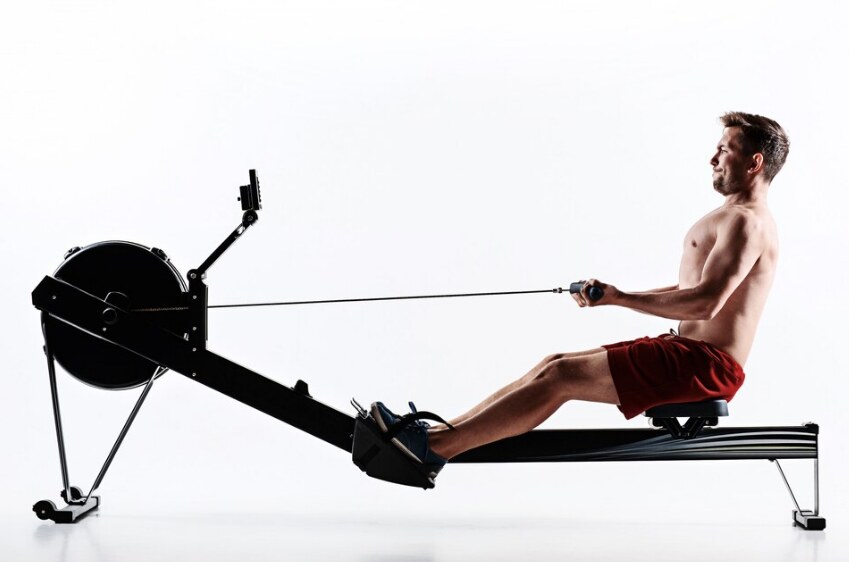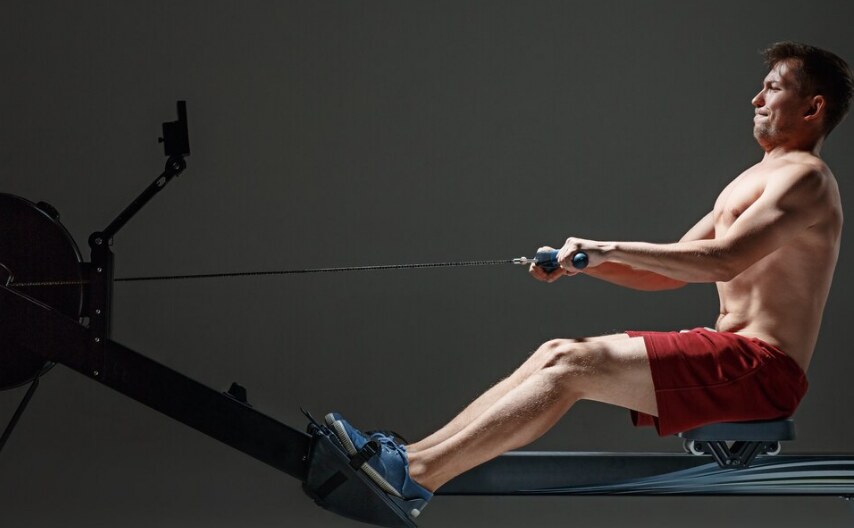Rowing is a dynamic, full-body cardio workout that engages nearly every muscle group, making it an efficient exercise for both strength and endurance. Whether you’re looking to lose weight, improve cardiovascular health, or build muscle tone, rowing offers a comprehensive solution.
Unlike traditional cardio exercises like running or cycling, rowing combines both aerobic and anaerobic benefits, giving you the best of both worlds in one workout.
When it comes to weight loss, rowing is particularly effective. Its high-calorie burn rate, coupled with the engagement of the legs, core, and arms, helps maximize fat loss while toning the body. Many wonder how much rowing per day is necessary for significant weight loss, how many calories you can burn during a session, and whether it’s truly effective for reducing belly fat.
In this guide, we’ll answer these common questions, providing insights into the real results you can expect, such as the benefits of rowing 30 minutes a day and how long to row for optimal fat loss. We’ll also dive into helpful tools like rowing machine calorie calculators to track your progress.

Why Rowing Is Effective for Weight Loss
Rowing is a powerful calorie-burning workout that can help you shed pounds efficiently. The rowing machine allows you to burn a significant number of calories in a relatively short amount of time. On average, rowing can burn anywhere from 300 to 500 calories in 30 minutes, depending on your intensity and body weight. This makes it a highly effective exercise for weight loss, especially when incorporated into a regular fitness routine.
One of the main reasons rowing is so effective is that it engages multiple muscle groups at once. Unlike other cardio exercises that primarily target the legs or the upper body, rowing activates the legs, core, and arms, leading to a full-body workout. The continuous push-pull motion of the rowing stroke recruits muscles in your legs, glutes, back, arms, and core, resulting in higher energy expenditure and greater fat-burning potential.
When compared to other forms of cardio, rowing stands out, especially when it comes to burning belly fat. For example, a treadmill workout primarily focuses on lower-body movement, which limits the engagement of upper-body muscles. Rowing, on the other hand, engages the entire body, resulting in a higher calorie burn overall, making it an excellent choice for those looking to lose weight and target stubborn areas like the belly.
Does Rowing Burn Belly Fat?
One common misconception is that you can target fat loss in specific areas of the body, such as the belly. However, fat loss occurs throughout the body as a whole, not just in isolated spots. While rowing helps burn fat, including belly fat, it’s important to combine it with a balanced diet and overall fitness routine to achieve the best results. Rowing can be a key part of this equation, but it’s not a magic solution on its own.
How Many Calories Can You Burn with Rowing?
Rowing is a highly efficient exercise for burning calories, but the exact number of calories you can burn depends on various factors, including your body weight, rowing intensity, and duration. Let’s break down the calorie burn for different rowing sessions and help you estimate how many calories you could burn using a rowing machine.

Calories Burned Rowing 5000 Meters
Rowing 5000 meters (approximately 3.1 miles) can take anywhere from 20 to 30 minutes depending on your speed and intensity. On average, someone weighing 155 pounds (70 kg) can burn around 400 calories rowing 5000 meters at a moderate pace. If you increase your intensity, this number can rise significantly. Heavier individuals will typically burn more calories due to the increased energy expenditure required.
Rowing Machine Calorie Calculator
A rowing machine calorie calculator helps you estimate how many calories you burn based on your weight and workout intensity. For example, if you weigh 155 pounds and row for 30 minutes at a moderate pace, you can expect to burn around 300-400 calories. On the other hand, if you row at a high intensity, you might burn up to 500 calories in 30 minutes.
Rowing Machine Weight Loss Chart
Here’s a basic calorie burn estimate based on different body weights and durations:
| Weight | 10-Minute Session | 30-Minute Session | 5K Rowing Session (Approx. 20-30 min) |
| 125 lbs (57 kg) | 70 calories | 210 calories | 350-400 calories |
| 155 lbs (70 kg) | 85 calories | 255 calories | 400-450 calories |
| 185 lbs (84 kg) | 100 calories | 300 calories | 450-500 calories |
| 215 lbs (98 kg) | 115 calories | 345 calories | 500-550 calories |
As you can see, the more you weigh, the more calories you will burn in the same amount of time.
Calorie Burn Estimates for Specific Sessions
- 10-Minute Rowing Session: A quick, 10-minute rowing session can burn between 70-115 calories depending on your weight and intensity. This is a great way to squeeze in a short, calorie-burning workout.
- 30-Minute Rowing Session: A moderate 30-minute session typically burns around 210-345 calories, offering a solid workout for weight loss.
- 5K Rowing Session: Rowing 5000 meters (5K) will take you about 20-30 minutes depending on your pace, and you can burn anywhere from 350-550 calories.
Rowing Machine Weight Loss Calculator Example
To calculate how many calories you burn during a rowing session, here’s a simple formula you can use:
- Estimate your MET (Metabolic Equivalent of Task) value for rowing (varies by intensity):
- Moderate rowing: 7 METs
- Vigorous rowing: 10 METs
- Calculate your calorie burn using the formula:
Calories burned=MET value×Weight in kg×Duration in hours
For example, if you weigh 155 lbs (70 kg) and row at moderate intensity (7 METs) for 30 minutes (0.5 hours), your calorie burn would be:
7×70×0.5=245 calories burned7
This provides a rough estimate of how many calories you can expect to burn based on your workout specifics.
Rowing Machine Weight Loss Results & Success Stories
Many people have successfully used rowing machines to lose weight and transform their bodies. With consistent effort, rowing can deliver impressive results in terms of fat loss, muscle tone, and overall fitness. Let’s dive into some real-life transformations and success stories to highlight the effectiveness of rowing for weight loss.
Before and After Transformations
One of the most powerful aspects of rowing is its ability to help people shed fat while building lean muscle. Take Sarah, for example: After committing to rowing 3-4 times a week for 30 minutes each session, Sarah lost 20 pounds in just 3 months.
Not only did she see a noticeable reduction in body fat, but her muscle definition, especially in her legs and arms, improved dramatically. This transformation is not unique—many individuals have experienced similar results by incorporating rowing into their fitness routine.
Another success story is James, who struggled with weight for years. He started with shorter sessions on the rowing machine and gradually increased his workout time. After 6 months of consistent rowing, James dropped 30 pounds and significantly reduced his belly fat. His energy levels soared, and he noticed improved endurance and strength.
User Experiences: “Is Rowing Good for Weight Loss Reddit?”
Reddit is filled with success stories and testimonials from people who’ve used rowing for weight loss. On the “Is rowing good for weight loss” threads, users share their personal journeys, offering a wealth of information on how they achieved their goals.
One Reddit user, “fit_rower24,” shared that after committing to rowing 30 minutes a day for 6 months, they lost 25 pounds. They noted that the key to success was consistency and tracking progress. Another user, “healthie_at_30,” recommended rowing in combination with healthy eating for the best results. Their transformation included a 15-pound weight loss over 3 months, with major improvements in muscle tone.
Rowing 30 Minutes a Day Results
If you’re wondering what results you can expect by rowing 30 minutes a day, the answer varies depending on factors such as intensity, diet, and your starting point. However, rowing for 30 minutes a day can lead to significant weight loss over time.
On average, a person can burn anywhere from 250 to 400 calories per session. If combined with a balanced diet, you could expect to lose 1-2 pounds per week, which aligns with safe and sustainable weight loss guidelines. Over the course of a month, that could add up to 4-8 pounds lost!
Expected Weight Loss Timelines
While rowing is an effective weight loss tool, it’s important to set realistic expectations. For most people, noticeable results may take anywhere from 4 to 8 weeks of consistent rowing. In this time frame, you can expect to see improvements in both fat loss and muscle tone. However, individual results vary depending on factors such as metabolism, dietary habits, and intensity of workouts.
How Long Should You Row to Lose Weight?
When it comes to using rowing as a tool for weight loss, the key is consistency and intensity. While there is no one-size-fits-all answer, understanding how much rowing per day is effective for fat loss can help you create a routine that fits your goals and lifestyle. Let’s break down the best practices for rowing to shed pounds and get into shape.
How Much Rowing Per Day for Effective Fat Loss?
For optimal weight loss, it’s generally recommended to aim for at least 30 minutes of rowing per day, 3-5 days a week. This allows you to burn a significant number of calories while avoiding overtraining. Rowing for 30 minutes at moderate intensity can burn between 250-400 calories, depending on your weight and rowing intensity.
Consistency is key: aim for at least 150 minutes of moderate-intensity aerobic activity each week, which translates to about 30 minutes per day, 5 days a week. This aligns with CDC guidelines for general fitness and fat loss.
If you’re looking to increase fat burn, incorporating higher-intensity rowing sessions or interval training (HIIT) can speed up weight loss by increasing your post-workout calorie burn (known as the afterburn effect).
Structured Rowing Workout Plans
To make your rowing routine more effective, here’s a breakdown of beginner, intermediate, and advanced rowing workouts:
- Beginner Rowing Plan:
Goal: Build endurance and get comfortable with the rowing machine.- Duration: 15-20 minutes
- Frequency: 3 days per week
- Intensity: Low to moderate (keep a steady, comfortable pace)
- Example Session:
- Warm-up: 5 minutes easy rowing
- Row at a moderate pace for 10-15 minutes
- Cool-down: 5 minutes easy rowing
- Intermediate Rowing Plan:
Goal: Increase intensity and start pushing for higher calorie burn.- Duration: 30 minutes
- Frequency: 4-5 days per week
- Intensity: Moderate (higher intensity intervals)
- Example Session:
- Warm-up: 5 minutes easy rowing
- 4 x 5-minute intervals: 1 minute at a hard pace, 4 minutes at moderate pace
- Cool-down: 5 minutes easy rowing
- Advanced Rowing Plan:
Goal: Maximize calorie burn and increase rowing power.- Duration: 40-60 minutes
- Frequency: 5-6 days per week
- Intensity: High (include sprints and resistance settings)
- Example Session:
- Warm-up: 5 minutes easy rowing
- 10 x 1-minute sprints at maximum intensity with 1-minute rest in between
- Row at a moderate pace for 20-30 minutes
- Cool-down: 5-10 minutes easy rowing
Rowing 5K a Day for Weight Loss
Rowing a full 5K (5000 meters) per day can be an excellent way to burn calories and improve cardiovascular health. A 5K row typically takes around 20-30 minutes depending on your speed and effort. While rowing 5K every day may not be necessary for everyone, it can certainly accelerate weight loss for those looking for a more challenging workout. The key is to gradually build up your stamina and ensure you’re maintaining good form.
Rowing 5K a day can burn anywhere from 350 to 550 calories, depending on your pace and body weight. This can significantly contribute to your weight loss goals when combined with a healthy diet and other forms of exercise.
Rowing 30 Minutes a Day
Rowing for 30 minutes a day can deliver substantial results, especially if you maintain consistency. As mentioned earlier, a moderate 30-minute rowing session can burn 250-400 calories, and when done regularly, you can expect to see steady progress over time. If you’re aiming for 1-2 pounds of weight loss per week (the recommended rate for healthy weight loss), rowing 30 minutes a day, combined with proper nutrition, can help you achieve that goal.
Rowing vs. Other Cardio Machines for Weight Loss
When choosing a cardio machine for weight loss, it’s important to consider your fitness goals, preferences, and body type. Two of the most popular machines for burning fat are the rowing machine and the treadmill. Both offer excellent cardiovascular benefits, but there are some key differences in how they help with fat loss, especially belly fat. Let’s compare rowing to treadmill workouts to see which might be the best choice for you.

Rowing vs. Treadmill: Fat-Burning Comparison
| Feature | Rowing Machine | Treadmill |
| Calories Burned per Session | 250-500 calories (depending on intensity) | 250-400 calories (depending on intensity) |
| Muscle Groups Engaged | Full-body workout (legs, core, arms, back) | Primarily lower body (legs and core) |
| Impact on Joints | Low impact | High impact (especially running) |
| Belly Fat Reduction | Engages entire body, promoting overall fat loss, including belly fat | Primarily burns calories but with limited upper-body engagement |
| Intensity Control | Adjustable resistance, intervals, and strokes | Speed and incline control |
| Cardio Benefits | Excellent for cardiovascular endurance | Excellent for cardiovascular endurance |
| Convenience | Compact and easy to store | Requires more space, especially for running treadmills |
| Accessibility for Beginners | Easy to learn, lower impact for those with joint issues | Simple for walking, but running can be harder for beginners |
Advantages of Rowing
- Full-Body Engagement: Rowing activates the legs, arms, core, and back, providing a more comprehensive workout compared to the treadmill, which primarily targets the legs.
- Low Impact: Rowing is easier on the joints, making it a great option for those with joint issues or those looking for a low-impact cardio workout.
- Increased Calorie Burn: Due to the full-body engagement, rowing tends to burn more calories in the same amount of time compared to treadmill walking or jogging.
- Efficient for Fat Loss: Rowing can help burn fat more effectively since it targets multiple muscle groups, which increases overall calorie expenditure and encourages fat loss throughout the body, including stubborn areas like the belly.
Advantages of Treadmill
- Familiarity and Accessibility: Walking and running on a treadmill are familiar movements that most people can do with little instruction. It’s ideal for beginners or those just starting their fitness journey.
- Variety in Intensity: You can control intensity by adjusting speed and incline, which can simulate uphill running and increase calorie burn.
- Space for Running: Treadmills are ideal if you’re someone who enjoys running as part of your routine.
Rowing vs. Treadmill for Belly Fat
When it comes to belly fat reduction, both machines can be effective, but rowing offers an edge due to its full-body engagement. While running on a treadmill primarily focuses on the lower body, rowing activates the core more significantly. This leads to greater overall calorie burn, which is essential for fat loss, including in the belly region.
However, it’s important to note that spot reduction (targeting fat loss in one area) isn’t possible—losing belly fat requires overall fat loss, and both rowing and running can help with that when combined with a healthy diet.
Tips for Maximizing Weight Loss on a Rowing Machine
Rowing is an excellent cardio workout, but to maximize weight loss and get the best results, you need to incorporate a few key strategies. Let’s dive into how you can enhance your rowing routine for effective fat loss and avoid common pitfalls.

1. The Importance of Intensity & Interval Training
One of the best ways to burn more calories and increase fat loss is by increasing the intensity of your workouts. Simply rowing at a moderate pace won’t burn as many calories as rowing at a high intensity. To get the most out of your rowing sessions, try incorporating interval training (HIIT). By alternating between high-intensity sprints and lower-intensity recovery periods, you can elevate your heart rate, increase calorie burn, and boost fat loss. For example:
HIIT Rowing Workout:
- Warm-up: 5 minutes at a moderate pace
- 30 seconds of maximum effort rowing
- 1 minute of easy rowing or rest
- Repeat for 20-30 minutes
- Cool-down: 5 minutes at a moderate pace
Interval training has the added benefit of increasing the afterburn effect (EPOC – Excess Post-Exercise Oxygen Consumption), meaning you’ll continue burning calories even after your workout is finished.
2. Strength Training + Rowing for Better Results
While rowing is an excellent full-body workout, combining it with strength training can accelerate weight loss. Strength training builds lean muscle mass, which helps boost your metabolism and increases the number of calories you burn at rest. Incorporating exercises like squats, lunges, push-ups, or weightlifting 2-3 times a week can complement your rowing workouts and make your body more efficient at burning fat.
Sample Weekly Routine:
- Monday: 30 minutes of rowing + 20 minutes of strength training
- Wednesday: 30 minutes of rowing intervals
- Friday: 30 minutes of rowing + 20 minutes of strength training
- Sunday: Full-body strength workout
By pairing strength training with rowing, you not only burn calories during your workout, but you also improve muscle definition and overall fat loss.
3. How Nutrition Plays a Key Role in Fat Loss
No matter how much you row, if your nutrition isn’t aligned with your weight loss goals, it’ll be much harder to shed fat. Nutrition plays a crucial role in fat loss because what you eat influences your calorie intake and metabolic rate. Here are some tips:
- Caloric Deficit: To lose weight, you need to consume fewer calories than you burn. Track your food intake and aim for a healthy caloric deficit (usually 500-750 calories per day for safe weight loss).
- Prioritize Protein: Protein helps build muscle, keeps you full, and supports recovery. Include lean protein sources like chicken, fish, tofu, or beans in your meals.
- Balance Carbs & Fats: Carbs provide energy for your workouts, and healthy fats (like avocado, nuts, and olive oil) support hormone function. Focus on whole, unprocessed foods.
- Hydration: Stay hydrated before, during, and after workouts. Dehydration can affect performance and recovery, making it harder to lose weight.
4. Common Mistakes to Avoid
While rowing is an effective fat-burning exercise, there are some common mistakes people make that can hinder their progress:
- Using Poor Form: Rowing with improper form can lead to injury and less effective calorie burning. Ensure you maintain good posture, engage your core, and use your legs to drive the motion, not just your arms.
- Lack of Variety: Doing the same rowing routine day in and day out can cause your body to plateau. Incorporate different rowing styles (sprints, steady-state, intervals) and vary your intensity to keep your body challenged.
- Overtraining: While consistency is important, too much rowing without adequate recovery can lead to fatigue and burnout. Aim for 3-5 rowing sessions a week, allowing your body time to rest and rebuild.
- Skipping Warm-ups and Cool-downs: Skipping a proper warm-up and cool-down can lead to injuries and hinder recovery. Always start with 5-10 minutes of light rowing to prepare your muscles and finish with a cool-down to promote recovery.
Conclusion
Rowing is an incredibly effective workout for weight loss, offering a full-body cardio experience that burns calories, builds muscle, and improves overall fitness. By engaging multiple muscle groups, rowing boosts your calorie expenditure, making it a fantastic choice for those looking to shed pounds and reduce belly fat. Whether you’re aiming for short, intense intervals or steady-state rowing, consistency is key to seeing results.
To maximize weight loss, incorporate high-intensity interval training, combine strength training with rowing, and stay mindful of your nutrition. Tracking your progress is essential, and using tools like a rowing machine calorie calculator can help you stay on track and make adjustments as needed.
Ready to start your rowing journey? Try out different rowing workouts and challenge yourself to gradually increase your intensity. As you see your progress, don’t forget to share your experience with others—it can motivate and inspire others to begin their own fitness transformation!
Start rowing today and let the results speak for themselves!


